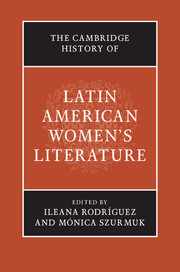Book contents
- The Cambridge History of Latin American Women’s Literature
- The Cambridge History of Latin American Women’s Literature
- Copyright page
- Dedication
- Contents
- Notes on Contributors
- Book part
- Introduction
- Part I Women in Ancient America: The Indigenous World
- Part II Women Writers in Creole Societies: Nation Building Projects
- Part III Women Writers In-Between: Socialist, Modern, Developmentalists, and Liberal Democratic Ideals
- Part IV Women Writers in a One–World Global System: Neoliberalism, Sexuality, Subjectivity
- 29 Market and Nonconsumer Narratives
- 30 Per-verse Latin American Women Poets
- 31 Beyond the Book
- 32 Literature about Feminicide in Ciudad Juárez
- 33 Afterword
- Bibliography
- Index
- References
31 - Beyond the Book
New Forms of Women’s Writing
from Part IV - Women Writers in a One–World Global System: Neoliberalism, Sexuality, Subjectivity
Published online by Cambridge University Press: 05 November 2015
- The Cambridge History of Latin American Women’s Literature
- The Cambridge History of Latin American Women’s Literature
- Copyright page
- Dedication
- Contents
- Notes on Contributors
- Book part
- Introduction
- Part I Women in Ancient America: The Indigenous World
- Part II Women Writers in Creole Societies: Nation Building Projects
- Part III Women Writers In-Between: Socialist, Modern, Developmentalists, and Liberal Democratic Ideals
- Part IV Women Writers in a One–World Global System: Neoliberalism, Sexuality, Subjectivity
- 29 Market and Nonconsumer Narratives
- 30 Per-verse Latin American Women Poets
- 31 Beyond the Book
- 32 Literature about Feminicide in Ciudad Juárez
- 33 Afterword
- Bibliography
- Index
- References
Summary
- Type
- Chapter
- Information
- The Cambridge History of Latin American Women's Literature , pp. 527 - 542Publisher: Cambridge University PressPrint publication year: 2015

